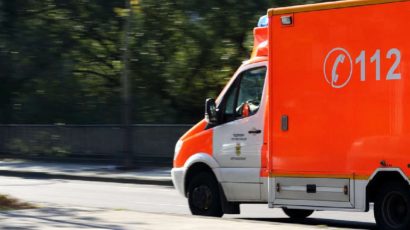
What is the significance of those five red circles? And why are we talking about it? This is the ‘Chain of Survival’ – created by Mary Newman, president of the Sudden Cardiac Arrest Foundation, who published this concept in the Journal of Emergency Medical Services in 1989. The Swiss Resuscitation Council recommend the use of this metaphor to visually demonstrate just how people who have heart attacks can be saved.
- The first link is the recognition that someone’s heart has stopped and to call the emergency services (144 or 112).
- The second link is starting Cardio-Pulmonary Resuscitation (CPR) as quickly as possible. This can be with chest compressions only instead of the traditional rescue breaths alternating with chest compressions (there is new evidence to show how effective compression-only CPR is!)
- The third link is using a defibrillator to try to restart the person’s heart. These are in one of those red or green boxes that you might have seen in airports, shopping centres, sports centres, work places etc. Anyone can use them!
- The fourth link is the advanced medical care that paramedics, doctors, nurses arriving at the scene can give – oxygen, medications, fluids and more.
- The final link is the expert treatment that the person will receive in the hospital once their heart is beating again.
As with any chain, it is only as strong as its weakest link. What do you think the weakest link is….? It is link number one. Do you know how to recognise whether someone’s heart has stopped? What do they look like? What sounds might they make?
The next weakest link is the second one – the fast starting of good CPR by you – the bystander. If you know how to do this (and it is easy to learn and practice) then you will significantly increase the chance of your friend, family member or other person surviving and leaving hospital alive! In the studies referenced below, it was discovered that someone who was given CPR from the emergency services only, once the ambulance had travelled to the scene, had a 22% chance of survival. But those who had received CPR from bystanders had a 43% chance of survival – a remarkable increase.
One of the most important reasons for this is that during CPR you are pumping their blood around their body and supplying the brain with oxygen, glucose and other important chemicals. The brain cells are kept more alive and therefore so does the person.
We all know that we should be trained in CPR. Its just that life gets so busy with work, family, chores and so on! Be a strong, not weak, link in this chain and help someone leave hospital smiling and ready to go. Get trained this Autumn, click here to book your place on a CPR course.
References:
Thompson RG, Hallstrom AP, Cobb LA. Bystander-initiated cardiopulmonary resuscitation in the management of ventricular fibrillation. Ann Intern Med 1979; 90:737.
Stiell IG, Wells GA, Field B, et al. Advanced cardiac life support in out-of-hospital cardiac arrest. N Engl J Med 2004; 351:647.
Valenzuela TD, Roe DJ, Cretin S, et al. Estimating effectiveness of cardiac arrest interventions: a logistic regression survival model. Circulation 1997; 96:3308.
Adielsson A, Hollenberg J, Karlsson T, et al. Increase in survival and bystander CPR in out-of-hospital shockable arrhythmia: bystander CPR and female gender are predictors of improved outcome. Experiences from Sweden in an 18-year perspective. Heart 2011; 97:1391.
Wissenberg M, Lippert FK, Folke F, et al. Association of national initiatives to improve cardiac arrest management with rates of bystander intervention and patient survival after out-of-hospital cardiac arrest. JAMA 2013; 310:1377.





